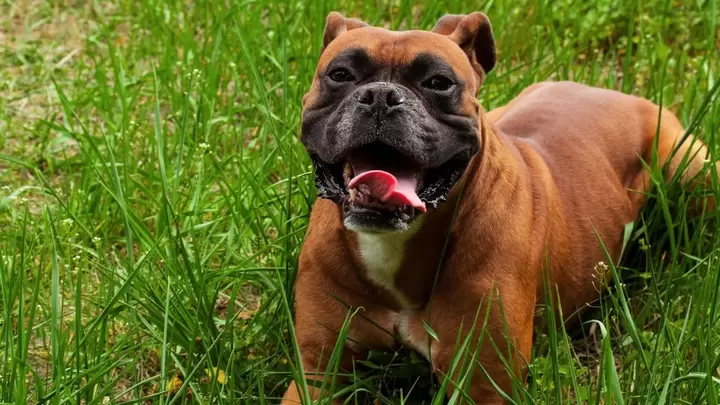Boxers originated in Germany in the late 19th century where they were bred to be versatile working dogs. They were developed by crossing the Bullenbeisser, a large and heavy dog used for bull baiting, with English Bulldogs and Terriers.
This created a breed that was suitable for blood sports like bull baiting and dog fighting where dogs would be set to bait and hold large animals like bulls and bears. However, once such blood sports became banned, Boxers emerged as family companions and guard dogs. “Boxers are Considered the Worst Dogs“.
While boxers have a history associated with blood sports, with proper training and socialization they can make loyal and affectionate family pets.
The Boxer is a medium to large breed with a square and muscular body. Males stand 21-25 inches tall at the shoulder and weigh between 65-80 pounds on average. Females are slightly smaller at 20-24 inches tall and 55-70 pounds.
Their coats are short, smooth and lying flat against the body. Colors include fawn, brindle or white with markings. They have a square muzzle, distinct fold of skin above their eyes, and large, broad chest.
Their large, round eyes give them an expression that is described as puppylike even in adulthood.
Boxers have an energetic and playful yet dignified temperament. They are highly intelligent dogs that take well to training. However, their strong prey drive from their historical use in blood sports also means they require socialization from a young age.
Their desire to please and devotion to their human families makes them excellent family companions when properly cared for and trained. However, their boisterous energy levels and stubborn tendencies are what often lands them on lists of worst dog breeds for inexperienced owners. Let’s explore further why Boxers are considered one of the most difficult dogs to live with.
Behavioral Challenges of Boxers
Stubborn and Strong Willed Temperament
Boxers have a very strong mind of their own from a young age due to their high intellect. They can be quite defiant and stubborn especially during the adolescent stage between 6 months to 2 years old.
Without consistent leadership and training from owners during this formative period, undesirable behaviors may solidify as the dogs get older. Early puppy classes help socialize Boxers and teach them manners, but owners must commit to daily practice and not give into the dog when they try to challenge or test boundaries.
Positive reinforcement training methods work best to motivate Boxers to comply without using force or punishment that could damage the human canine relationship.
Stubborn behaviors commonly seen in untrained Boxers include ignoring commands, refusing to release items in their mouth when asked to drop it, pushing for more attention by nipping, jumping on people or vocalizing excessively.
These types of behaviors stem from the dog feeling they can control the household if the owner has not properly established themselves as the pack leader through respect and consistency.
Without strong and balanced leadership ingrained from day one of bringing a Boxer puppy home, owners will have an uphill battle with a defiant adolescent and adult dog.
Excessive Energy Levels
Boxers have incredibly high energy needs due to their muscular physique and being bred as working dogs. They require at minimum an hour of vigorous physical exercise per day, plus additional interactive playtime indoors.
Examples of activities Boxers enjoy include long walks, jogs or runs, fetching games in an enclosed yard, swimming, hiking on trails, agility classes and more. Failure to adequately meet these exercise demands through varied activities will result in pent up energy manifesting as troublesome behaviors at home.
Boxers left bored or under stimulated may become restless, destructive through excessive chewing, barking excessively for attention, counter surfing or getting into the trash. It’s not enough to just let a Boxer out in the backyard they need structured play or sports sessions with their humans each day.
Without sufficient activity, Boxers can become rambunctious and difficult to control indoors as well as potentially develop unwanted obesity or other health issues down the line. Planning a routine that engages their mind and body is key when owning this high drive breed.
Vocalization Behaviors
Boxers tend to be quite vocal and are known for barking, howling or whining. This is due in part to their instinctual vocalizations during historical bull baiting events.
Some common reasons for Boxer vocalizations include when bored and seeking attention or play, separation anxiety when left alone, excitement during greetings or play, trying to alert their humans about strangers approaching the home, or frustration.
Without training, Boxers may bark or cry excessively which can disturb neighbors in close living quarters like apartments or housing developments. Early socialization plus reinforcement training is important to curb unneeded vocalizations and teach your Boxer an “indoor voice” so they don’t lose their barking privilege entirely.
Be sure to address the root cause behind the vocal outburst each time as Ignoring the behavior won’t result in the desired quieter demeanor.
Health and Medical Concerns
Hip Dysplasia
Boxers unfortunately have a high chance of developing hip dysplasia. This painful orthopedic condition occurs when the thighbone does not fit snugly into the hip joint, causing the bones to rub together abnormally.
Over time this damages cartilage and leads to arthritis. Hip dysplasia has been attributed to the rapid growth rate of large breed puppies and genetics.
Reputable breeders screen parent dogs through the Orthopedic Foundation for Animals (OFA) certification toSelect breeding stock with minimal hip abnormalities based on x-ray evaluators.
However, hip dysplasia still persists and one in four Boxers will have mild to severe signs by two years of age if not bred conscientiously. To help prevent hip issues, owners should keep Boxer puppies lean by limiting calorie dense treats and keeping exercise moderate on developing joints until fully grown. Signs like reluctance to jump or limping are reasons to consult your vet.
Skin Fold Dermatitis
Due to their loose facial skin folds, Boxers are predisposed to infections if those areas aren’t kept clean and dry. The skins traps moisture, bacteria and allergens which can cause severe dermatitis, inflammation and hot spots if not attended to properly.
Daily gentle cleaning of the face, ears and neck creases with a damp cloth or hypoallergenic pet wipe is recommended.
Thoroughly drying the areas afterwards can also help. Antibiotics or antifungal creams may be necessary for any wounds or hot spots from scratching. Long term skin issues can deeply trouble Boxers and impact their quality of life, so prevention through consistent grooming is important.
Cardiomyopathy
Also called Boxer cardiomyopathy, this refers to genetic defects in the heart muscle that causes it to thicken. In more severe cases it can lead to congestive heart failure.
Boxer cardiomyopathy is the most common cause of death for the breed around 6-8 years of age on average. A cardiac vet check at around age 2 can screen for serious conditions with an echocardiogram. Medication may be needed if abnormalities appear, but catching it early gives the best prognosis.
Limiting stress and providing a healthy diet also supports cardiac wellness long term. Reputable breeding with screening reduces risk for offspring.
High Maintenance Commitment
Owning a Boxer requires dedication and accepting the responsibilities that come with their health risks and robust, energetic personality. While they make loving companions, their needs do demand a higher level of commitment compared to other calmer breeds.
Daily Grooming
Boxers shed moderately year round and seasonally shed heavier coats twice a year. Daily brisk brushing distributes skin oils and removes dead hair to minimize what ends up around the home.
Their wrinkles require regular cleaning to avoid infection. Every 4-6 weeks, stripping removes undercoat hairs that don’t fall out naturally. Frequent bathing also keeps odors away from their thick double coats. Proper hygiene management is indispensable for the breed’s well-being.
Consistent Training
As mentioned earlier, the intelligence and independence of Boxers means new owners must commit to puppy kindergarten classes and practicing learned commands daily.
This establishes the human as a respectable leader. Obedience training continues throughout life since strong willed Boxers will constantly test boundaries if slacking occurs.
Mental games and puzzles also tire their minds to curb undesirable behavior. Without regular sessions, owners risk losing control over these large yet soft dogs.
Medical Expenses
The common health conditions Boxers may face like allergies, cardiomyopathy, cancers and orthopedic issues drive up vet bills significantly over their average 10-13 year lifespan.
Wellness plans can cover routine care, but unexpected emergencies still incur costs. Major illnesses may require specialty veterinary procedures. Factoring in the high medical risks is prudent when budgeting as a Boxer owner. Pet insurance offers coverage should the unexpected occur.
FAQs About Boxers are Considered the Worst Dogs
Q:Why do Boxer dogs have a bad reputation?
A: Dangerous and aggressive
Q:What is the problem of Boxer dog?
A:Heart problems, degenerative myelopathy, bloat, and ulcerative colitis
Q:What is a bad behavior for a Boxer?
A:Dominant or aggressive toward other dogs of the same sex,
Conclusion
while affectionate and playful, Boxers are one of the most challenging breeds for new owners due to their boisterous energy levels, stubborn nature, training needs and frequent health monitoring required.
They thrive best with experienced handlers who understand canine behavior and are equipped for the commitment levels these dogs demand. With dedicated owners willing to meet their needs for activity, structure and attention through training, puzzles, sports and quality time, Boxers absolutely thrive as loving companions.
However prospective guardians must realistically evaluate if they have the time, space, resources and patience for a dog with moderate to high maintenance requirements before deciding on this breed. With proper care and socialization from day one though, many Boxers adjust smoothly to become wonderful family dogs.

Hi. My Name is Alexander Bell. I am a professional content writer since 2006.
18+ years of experience crafting compelling and authoritative content for diverse audiences.
🖋️ Specialize in formal article writing, combining meticulous research with engaging storytelling.
📚 Proven track record of delivering high-quality content across various industries, including technology, finance, and healthcare.
💡 Skilled in SEO best practices and optimizing content for digital platforms to maximize reach and engagement.
🔍 Strong research capabilities, adept at distilling complex information into accessible, informative articles.
🎓 BA in English Literature










